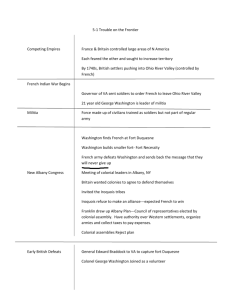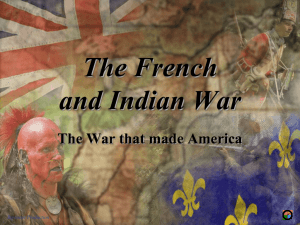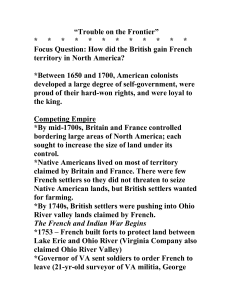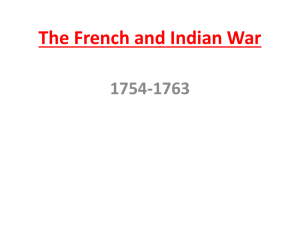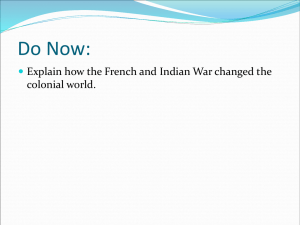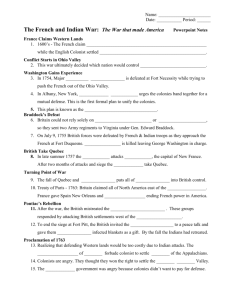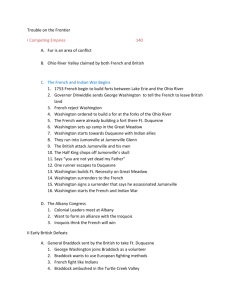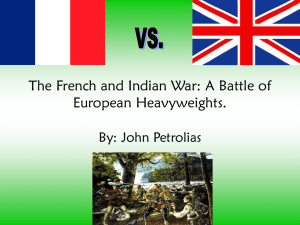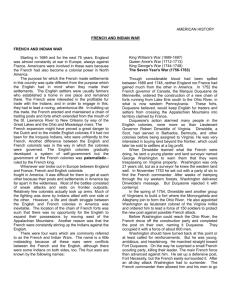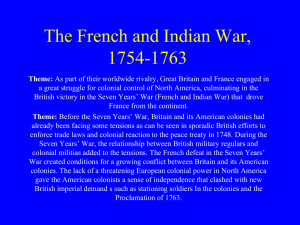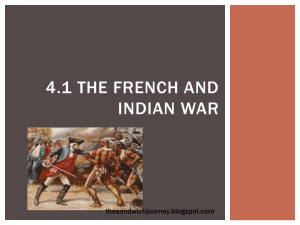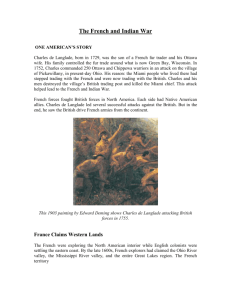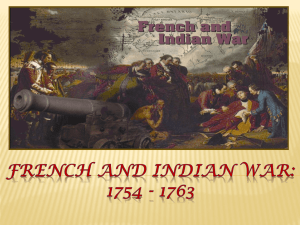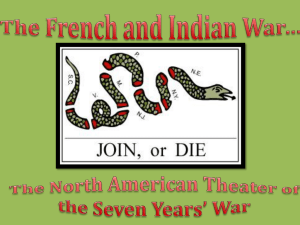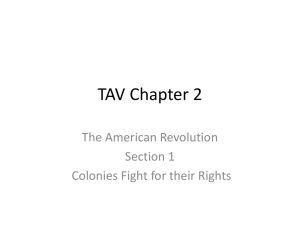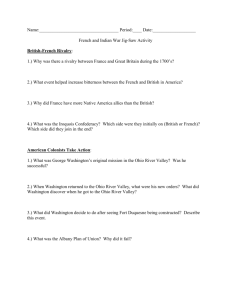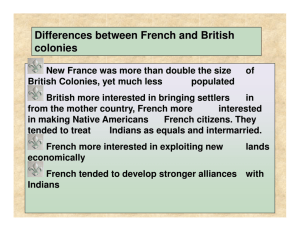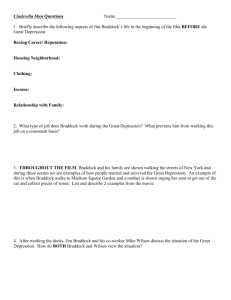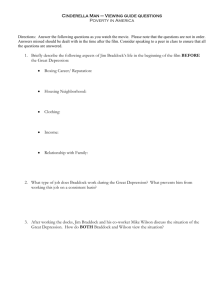Group Worksheet Fr. and Indian War
advertisement
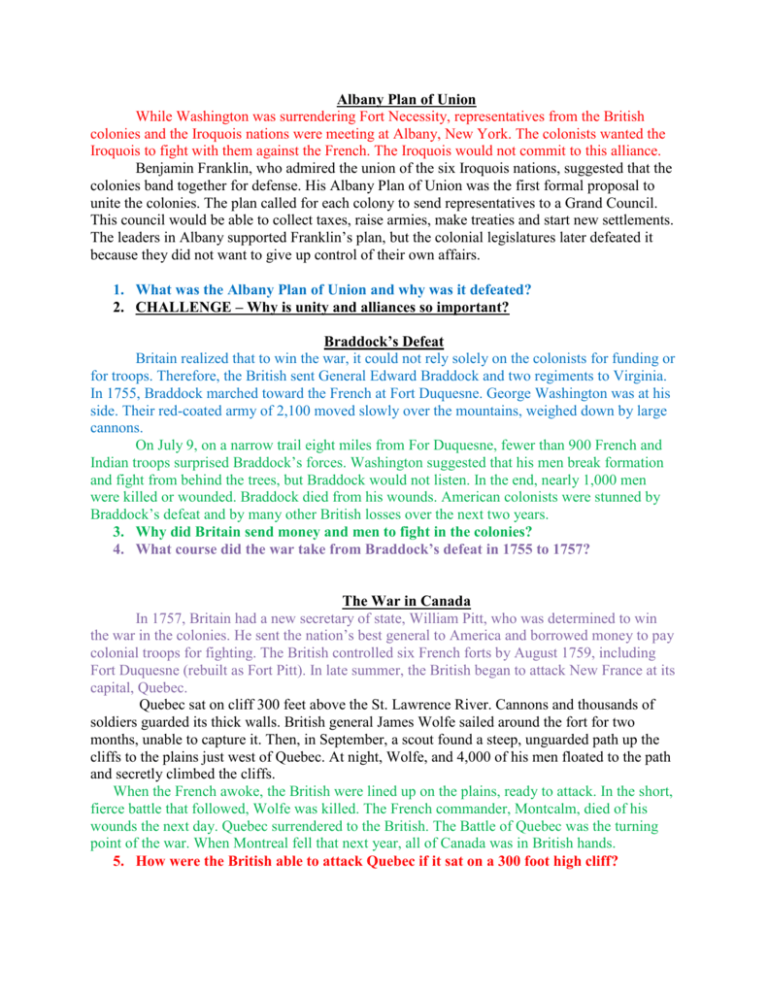
Albany Plan of Union While Washington was surrendering Fort Necessity, representatives from the British colonies and the Iroquois nations were meeting at Albany, New York. The colonists wanted the Iroquois to fight with them against the French. The Iroquois would not commit to this alliance. Benjamin Franklin, who admired the union of the six Iroquois nations, suggested that the colonies band together for defense. His Albany Plan of Union was the first formal proposal to unite the colonies. The plan called for each colony to send representatives to a Grand Council. This council would be able to collect taxes, raise armies, make treaties and start new settlements. The leaders in Albany supported Franklin’s plan, but the colonial legislatures later defeated it because they did not want to give up control of their own affairs. 1. What was the Albany Plan of Union and why was it defeated? 2. CHALLENGE – Why is unity and alliances so important? Braddock’s Defeat Britain realized that to win the war, it could not rely solely on the colonists for funding or for troops. Therefore, the British sent General Edward Braddock and two regiments to Virginia. In 1755, Braddock marched toward the French at Fort Duquesne. George Washington was at his side. Their red-coated army of 2,100 moved slowly over the mountains, weighed down by large cannons. On July 9, on a narrow trail eight miles from For Duquesne, fewer than 900 French and Indian troops surprised Braddock’s forces. Washington suggested that his men break formation and fight from behind the trees, but Braddock would not listen. In the end, nearly 1,000 men were killed or wounded. Braddock died from his wounds. American colonists were stunned by Braddock’s defeat and by many other British losses over the next two years. 3. Why did Britain send money and men to fight in the colonies? 4. What course did the war take from Braddock’s defeat in 1755 to 1757? The War in Canada In 1757, Britain had a new secretary of state, William Pitt, who was determined to win the war in the colonies. He sent the nation’s best general to America and borrowed money to pay colonial troops for fighting. The British controlled six French forts by August 1759, including Fort Duquesne (rebuilt as Fort Pitt). In late summer, the British began to attack New France at its capital, Quebec. Quebec sat on cliff 300 feet above the St. Lawrence River. Cannons and thousands of soldiers guarded its thick walls. British general James Wolfe sailed around the fort for two months, unable to capture it. Then, in September, a scout found a steep, unguarded path up the cliffs to the plains just west of Quebec. At night, Wolfe, and 4,000 of his men floated to the path and secretly climbed the cliffs. When the French awoke, the British were lined up on the plains, ready to attack. In the short, fierce battle that followed, Wolfe was killed. The French commander, Montcalm, died of his wounds the next day. Quebec surrendered to the British. The Battle of Quebec was the turning point of the war. When Montreal fell that next year, all of Canada was in British hands. 5. How were the British able to attack Quebec if it sat on a 300 foot high cliff? 6. CHALLENGE – Why do you think the British had the advantage in this battle for Quebec? Peace Britain and France battled in other parts of the world for almost three more years. Spain made a pact in 1761 to aid France, but its help came too late. When the Seven Years’ War ended in 1763, Britain had won. By the Treaty of Paris, Britain claimed all of North America east of the Mississippi River. To reward Spain for its help, France gave it New Orleans and Louisiana, the French territory west of the Mississippi. Britain, which had seized Cuba and the Philippines from Spain, gave them back in exchange for Florida. The treaty ended French power in North America. 7. What were the provisions (parts) of the Treaty of Paris? 8. CHALLENGE – What was the significance of the Treaty of Paris for the French?
